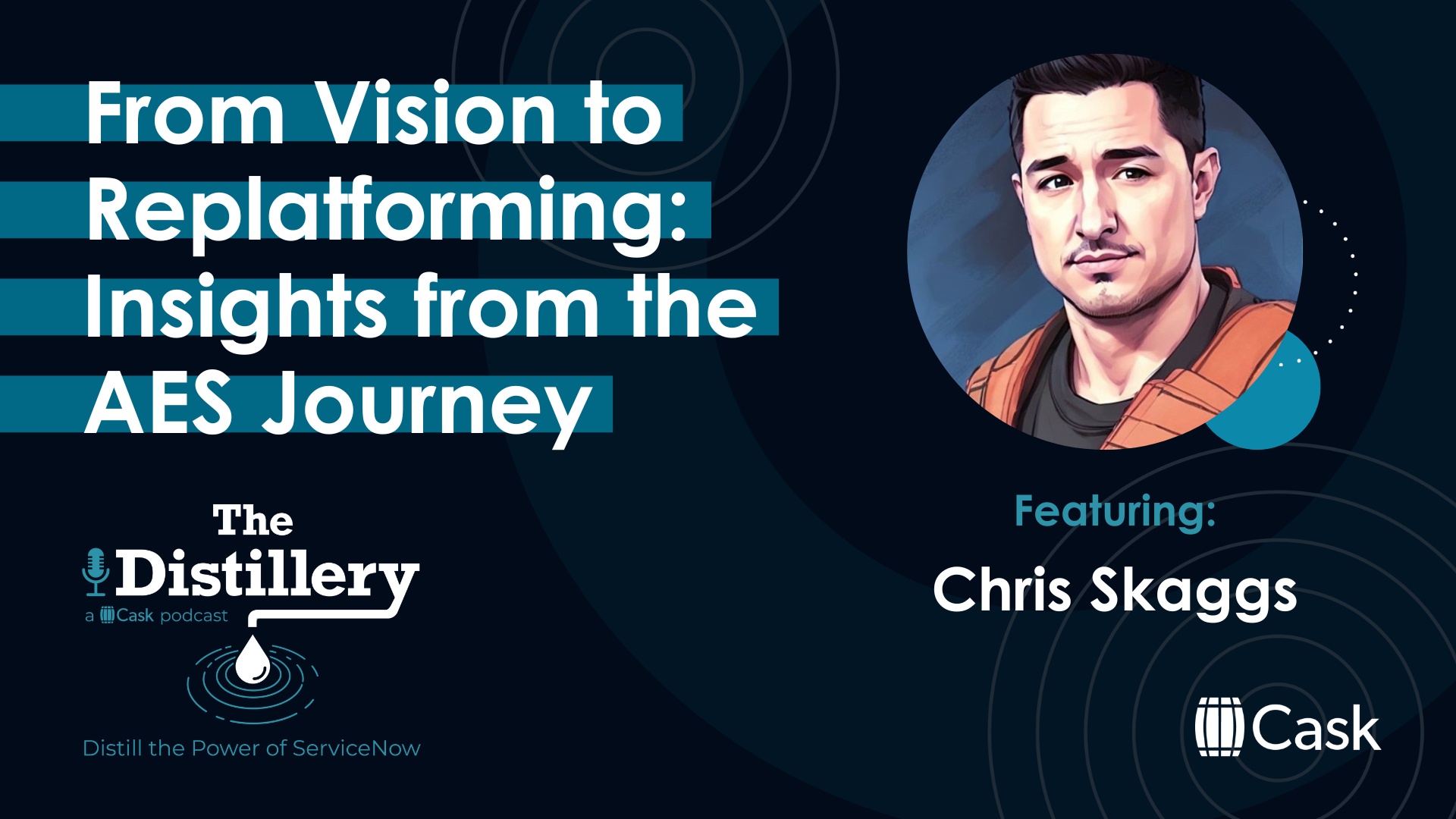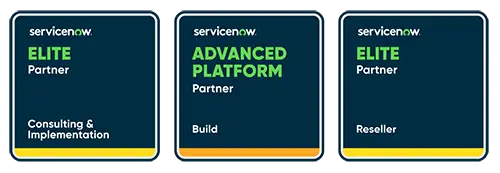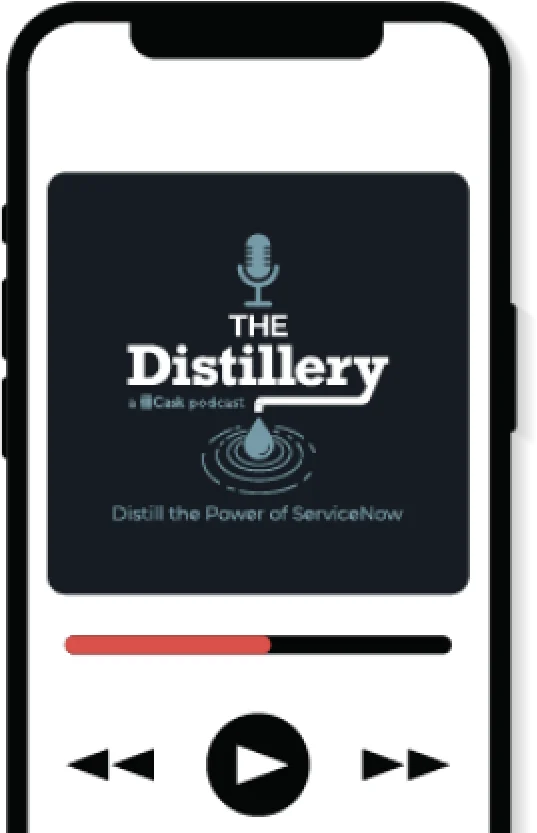Your Host:
Sean Dawson
Our Guest:
Chris Skaggs

Join Sean Dawson and Chris Skaggs, ServiceNow Global Product Owner at AES Corporation, as they explore the complex journey of managing technical debt and replatforming ServiceNow. Chris shares his decade-long experience in the ServiceNow ecosystem, highlighting his transition from consultant to platform owner. Discover how AES Corporation tackled challenges like massive technical debt, custom applications, and the need for governance, all while building a new vision for ServiceNow. If you're interested in ITSM, governance, or replatforming strategies, this episode is a must-watch!
Sean Dawson: Welcome again to the Cask Distillery Podcast, where we unlock the full potential of ServiceNow with expert insights and practical strategies, only here on the Cask Distillery Podcast. And with me today, I’ve got a special guest: Chris Skaggs, who comes to us as a customer and actually a former coworker. He’s now at ServiceNow. He’s the ServiceNow global product owner at the AES Corporation.
Welcome, Chris. Thank you for taking time out of your so-busy schedule to talk to me and everybody watching this today.
Chris Skagg: Yeah. Hey, Sean. Thanks for having me today.
Sean Dawson: Oh, no problem. I wanted you to also, if you could, give a little bit more of an intro than I did—a little bit more about your background before we get into some of the questions.
Chris Skaggs: Yeah, absolutely. As you said, I’m the global product owner at the AES Corporation. I started working in the ServiceNow space as of September. So this month, 10 years ago, actually, I was working with my role in the ServiceNow ecosystem at APS, another electric utility company here locally in Arizona.
And I was working in field services and wearing a lot of different hats. I was also a BlackBerry administrator at the time on the BES server. So, doing a lot of work. And we at APS had implemented ServiceNow Discovery, and I was brought in just to help with that, had really no background or understanding of ServiceNow other than incident management—a ticketing tool. And we did the implementation with Fruition Partners, a consultancy. (Now DXC, I think, owns Fruition.) But I was with Fruition, helping them out. And as we wrapped up that Discovery implementation, they said, “Hey, if you’re ever interested and you want to start working in the ServiceNow space, just apply for a position here at Fruition, and we’ll put in a good word for you.”
And so I did that. And 10 years ago, Fruition Partners hired me on as a technical consultant. And I did that for a while and moved in-house after doing an implementation over a couple of years with Symantec. And I was one of their ServiceNow administrators for a few years, jumped back into consulting again, working for Virteva, then Acorio, and also with you all—with Cask as well—primarily doing mostly solutioning, solution consultant, those types of roles in pre-sales. And then I am where I am today, 10 years later, at the AES corporation as their global product owner.
Sean Dawson: So you’ve really been on both industry and consulting, which is really a good broad set of experience. And now, at AES, you’re basically the platform owner, product manager, if you will. But at AES, coming in as a platform owner, how do you recommend identifying what and where the important things are to address when you come into a situation like that?
Chris Skaggs: Yeah, I think a lot of it comes down to, really, initially, I think, gauging the health of the platform and understanding where they’re at today. If you’ve administrated on the platform long enough, one of the first things you tend to do is look at upgrade history, “Let’s see what’s happened recently when they’ve upgraded this platform. I’ve never seen this platform before. So, what’s been going on?”
And right away you can look at how many skipped items somebody has after an upgrade. And when you start seeing that number creep over a few hundred, 500 plus—and in our case, we were looking at probably around 1,500 skipped items just on the most recent upgrade—that lets you know that there’s probably a lot of customization, right? A lot of technical debt going on within the platform.
And then after that, it’s really just trying to get an understanding, historically, of how the organization’s been using ServiceNow. Really, building relationships right away early on and knowing who are all the stakeholders both from an executive level and then really who owns the different areas of the platform historically. Who’s been doing, on the SMO side, for example, incident problem change? If you’re using other apps and modules, who, historically, has been the person that’s the focal point of contact when it comes to the things that have been done in that area of the ServiceNow platform?
And so once you start mapping those people out, who’s who, having conversations and just sitting down with them, “What are your thoughts on ServiceNow? Has it been something that’s been good for AES? Has it been something that’s been a challenge? What have you enjoyed about it?”
And then just really understanding the nuts and bolts of who’s who and what’s been going on historically within the platform itself. That lets you start mapping out the challenges, the areas that they’re probably strong in and they succeed in, and then really what has the governance looked like based on those people you’ve had those conversations with? Is it mature? Is it lacking? And you can start really, I think, getting the lay of the land and understanding what ServiceNow looks like.
Sean Dawson: Great. And you mentioned skipping updates, and what I wanted to ask you about next is dealing with all the inherited, really technical debt. And I was hoping you could talk to those watching and listening about some of the impacts of that technical debt that you basically inherited.
Chris Skaggs: Yeah. Well, the one thing is our organization, we’re a large global electric utility. And as far as ServiceNow is concerned, we’ve historically been and still even today handle through managed services. And that’s because the internal team itself at AES, we just haven’t had, I think, enough people that know ServiceNow well enough to say, “Hey, I’m somebody who can administrate the platform or develop on the platform.”
And beyond that, just the fact that we’ve run pretty lean lets you start to realize that, due to the amount of skipped updates that we have, people probably aren’t really managing. And that’s where I think I started to identify right away that governance was probably lacking a little bit. The fact that there was so many skipped items—and those skipped items themselves—there were not anything being done to address them. It was just skipped and no action taken. And what that meant for us was, and what it means for ServiceNow is that we weren’t seeing the fruits of all of the major releases. You could go into the release notes and say, “Hey, they’re doing this great thing with major incident, or they’re doing this other thing within SecOps.”
We weren’t seeing the benefits of a lot of those changes that were coming, because ServiceNow skips those things if you’ve made customizations to them. So the fact that we had so many, it was an instance that we had in place for six years prior to me coming on board And the fact that we were global, we started out in Brazil. Brazil initially managed our ServiceNow instance. Then it got handed off to one managed service partner, then another managed service partner, and then another. And over time, it expanded into Argentina and other areas of Latin America, El Salvador, the United States. We were all using the platform. And we were, essentially, as we grew, expanding from the ground level what Brazil had put in place.
Beyond the skipped items, what it meant, too, was right away, I’d go into tickets when I first came here, and short description and a lot of things on incidents or on some of the stuff within Agile enhancements and stories. They were in Spanish. They were in Portuguese. And so it was probably a matter of either people looking that were working on those tickets, as for fillers. They probably looked at those and said, “Oh, I’m not going to take that on.” And it’s just sad because it wasn’t in their native language. Or they were going in and opening it up and copying and pasting things into Google Translate and getting the best guess on what people were trying to say, and then working those tickets and updating them in their own native language.
And it just became a big disconnect between the fulfillers and between the people that were submitting tickets. And so all those things added up to a platform that was in a bit of disarray. There wasn’t really any gatekeeping going on. There were things, like I said, in multiple languages without dynamic translation in place. And it was just something that we needed to get our arms around and figure out how did we want to proceed forward at that point with where we were at with the state of the platform.
Sean Dawson: Wow. That’s a lot. I mean, walking into that. So when you start thinking about vision—you see, you walk in, you’ve got to deal with what’s there. You look at the technical debt—how did you go about defining and sharing your vision at that point?
Chris Skaggs: I was lucky in some ways. My director at the time that hired me on, she was essentially sharing some of the challenges they were facing on the platform. And all of it stemmed from that lack of governance and really just managed services saying “Yes,” because we were paying a bill, saying, “Hey, do this, do this.” And anytime anybody within the organization, no matter where they were located globally, if they came to the managed service partner and said, “Hey, we want this done within ServiceNow,” it was just a, “Yeah, we’ll go ahead and do it for you.” And she was of the mentality—the director that hired me—of, “Let’s blow this thing up. I want to start it all over again.”
And really, right away when I started talking to her about that, we were discussing how do we strategically do that the best way, in the right way. And that decision came down to—the vision, to your point, was, “Let’s go ahead and replatform ServiceNow.” That term, for those that aren’t familiar with replatforming, really is, “Let’s go ahead and stand up a brand-new instance of ServiceNow, and let’s try and do things from a best practice, out-of-the-box perspective.”
We don’t really call it customizations, or we don’t approach things from a customization perspective any longer. It’s really more of a configuration. You go into things that are already there. And if you’re not going through and changing some of the core things—the business rules that are out of the box—the script includes all the technical stuff that people probably are going to fall asleep trying to listen to on this podcast. But those things that are technical components, saying, “Let’s not really touch those things, but let’s figure out how we can properly configure this system so that it meets the needs but also allows us to continue to have those major instance upgrades and those new capabilities brought forth so we’re able to leverage those things.”
One big piece of that too that I’ll hit on is ServiceNow. They started out really as an IT service management solution—incident problem changed, ticketing solution in that regards with the service catalog. And over the years, they’ve expanded. HR, they went into. They went into SecOps. They’re going into OT (operational technologies). Even legal service delivery. There’s so many things that it’s doing nowadays beyond just IT service management.
When organizations like AES and others started using it, at the time, it didn’t have capabilities they needed. So they were using App Engine and a lot of other things to custom-build solutions and ticketing tools for those capabilities that weren’t there. And so, over the six years, we were saying, “Hey, we need to use some HR capabilities.” And we built our own custom HR solution and other things, too, on the platform. And those were a big piece, I think, of some of that technical debt we talk about. But ServiceNow brought those things into the platform over time.
And so we were at an intersection where, “Hey, we’ve got this custom app that does these things. ServiceNow has released this thing, and they continue each release to improve upon it and give them more capabilities.” And our stakeholders within HR and within other areas of AES are saying, “We would love to be able to do that as well.” Well, we can’t just bolt those things on to our custom application—it just builds more and more technical debt. And so you start to say, “I want to use those out-of-the-box capabilities.” And of course there’s licensing costs that come with that. And ServiceNow is not an inexpensive tool to use.
So you start saying, “Hey, we want to leverage those capabilities. How do we do that best?” And I think replatforming, for us, checked the boxes of saying, “Hey, we’re not going to be carrying a lot of those custom-built applications and capabilities. We’re going to start fresh and to the vision point. We’re going to give AES what they need when it comes to, ‘We want to be able to do some legal service delivery stuff,’ or ‘We want to do some OT stuff or HR stuff.’” And we can use those out-of-the-box capabilities and get the improvements that ServiceNow is giving us on top of that.
We really built that from there. The vision of these are the things that we want to do as far as our roadmap’s concerned. But let’s crawl, walk, run. Let’s get ourselves to the point of where we need to be with the best practice out-of-the-box solution and go from there.
And so we’ll talk more about it. There’s definitely some other challenges that have come with how we’ve replatformed and how we approach that, because we had to keep things afloat for everybody else. We couldn’t just stand this thing up, and then everything else everybody was using just be turned off immediately.
And so we’re wrapping up Replatforming now. We’ve had to do things in parallel with two production environments. So we’ll jump into that eventually. I don’t know if that answers your question, but I think that’s really where we started.
Sean Dawson: You did. You went really wide with that, which was great, because you actually addressed three of my questions in there. You talked about the vision, and you did hit on how the decision came to replatform. And fortunately, you, being a former solutions consultant, you talked about, naturally, what replatforming is. But then you also talked about your hopes, like why you were replatforming.
But I do want to hit on, and you mentioned this, is what were the concerns or issues about replatforming that you were concerned about, that were keeping you up at night? What were those? What did that look like?
Chris Skaggs: Yeah. A lot of it comes down to—I’ll start first with those custom apps. We’ve had capabilities that we’ve leveraged, and we implemented some of those things within the last two years. And so there was a cost up front. And we’re still working on our ROI on those implementations of those custom solutions. And with that, a big piece of anything you do on ServiceNow or, I think, within any tool within an organization, is OCM. And the organization spent a lot of money, a lot of time, a lot of resources on putting OCM in place around some of the things that we have, that HRP solution being one in particular.
And so one of the things that I learned through the process—and I think with my background being in a solution architect capacity and doing consulting—you tend to carry, and I think it’s very valuable, that sales skill with you, because you have to be able to sell the organization on your vision. And I was very gung ho at the time on saying, “Let’s move to the HRSD solution within ServiceNow.” And I don’t want to say I was being deaf to or not listening to HR within AES’s needs, but I think I was saying, “Yeah, I understand you guys spent a lot of money on this solution before and it does what you needed to do today, but think about what HRSD could do for you in the future and all these other things.”
And the reality was, HR case, the way we had built it, was perfect for our needs. That’s really all we were using it for. Workday was accommodating everything else. And a simple HR case ticketing tool was what HR needed. The licensing costs were very high, but the biggest piece of it that I was just talking about was that OCM effort—the training that we had to do to get this in place. And the fact that we were going to be replatforming meant that there was going to be a lot of change fatigue.
We’ve been doing this now for about a year with the replatforming. And most of it has been around the ITSM side of things, as well as putting an ITOM that we never had before ServiceNow Discovery to give us a CMDB that we never had, which is a huge compliment. ITSM is really the backbone of what you do within ServiceNow.
And so we’re getting that strong foundation in place. But to your point, that’s a big piece of what we want to do going forward is move into those AI capabilities within ServiceNow to help us.
Sean Dawson: Great. Well, thank you so much, Chris, for your time. I know how busy you are, and everybody’s busy, but you’re especially busy with everything you’ve got going on with the global situation, replatforming, all that. So thank you so much.
So for everybody watching, thanks again for tuning in. And please, do us a favor: like, subscribe, and suggest anything that you want to see, and we’ll see you on the next podcast. Take care.
Chris Skaggs: Bye bye.
We’re with you for what comes next
You're working in a rapidly shifting environment.
Global dynamics, AI advancements, heavy competition–the only certainty is change.
We get it. And we’re here to help you harness the full potential of ServiceNow to simplify transformation.
Let's navigate the future together.

Recent Episodes
We’re with you for what comes next
You're working in a rapidly shifting environment.
Global dynamics, AI advancements, heavy competition–the only certainty is change.
We get it. And we’re here to help you harness the full potential of ServiceNow to simplify transformation.
Let's navigate the future together.

Let’s Innovate Together!
Request a Complimentary Consultation from Cask.
Cask’s unparalleled expertise is ready to tackle your unique challenges and transform your aspirations into reality. We’ll listen to understand your requirements and offer a tailor-made approach that aligns with your strategic objectives.
Your journey to innovation is just a click away. Schedule your meeting with our Cask advisors and become part of the success story that defines your organization’s future.

Sign up for our Distillery Podcast
Stay up to date with the latest episodes







